Pig Sweep® Nano Chemical Process
E&P has created the first nanoparticle mechanical cleaning process for oil and natural gas pipelines.

What is Pig Sweep®?
The Pig Sweep® process is raising the bar for pipe cleaning services as well as allowing for the smooth flowing of oil and natural gas from the source to the refinery. Saving expensive and time-consuming testing and tailoring of your cleaning solutions.
Pig Sweep® uses Brownian motion as a mechanical solution versus a chemical reaction. The particles are held in a liquid solution composed of several drying agents and corrosion inhibitors. Leaving the chemistry of the pipe unchanged and in fact, drying the pipe improving dew point and leaving odorant unchanged.
Additionally, there is no need for special chemistry to address each kind of debris. Pig Sweep® addresses them all.
Why Use Pig Sweep®?
- Results Oriented / Driven
- New Innovative scientific methods for removing debris and unwanted deposits.
- No Odorant fade (mercaptan)
- Specifically designed for individual production systems
- Includes prep for I.LI. tool (smart pig), gauge plate, scraper pig, foam cleaning pig etc.
- Applications from piggable and non piggable lines
- Proven dew-point reduction and dehydration
- Cleans protects with biocidal tendencies
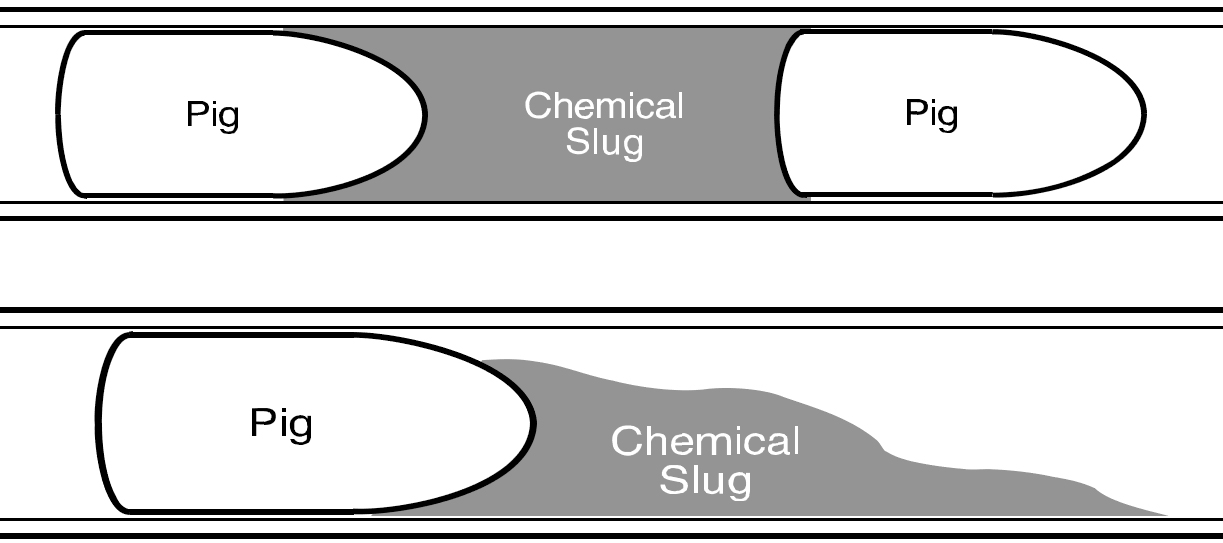
* Method of Cleaning Pipeline U.S. Patent No 11,077,474 for file EPSG-31637, Method of Cleaning Pipe U.S. Patent No 11,059,079 for file EPSG-31637-CON
Pig Sweep® Application Methods
- Batch, injecting a large volume of chemical in a short period of time
- Continuous, injecting a consistent amount of chemical for continual cleaning
- Extended Batch, injecting a specified amount of chemical over a designated length of time
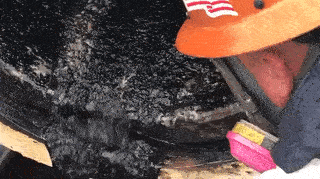
Get Started Today

Proceedings of the ASME 2022 14th International Pipeline Conference
IPC2022
September 26-30, 2022, Calgary, Alberta, Canada
IPC2022-86892
PIG SWEEP®: : NANOPARTICLES TRANSFORM PIPELINE
CLEANING A& INTEGRITY MANAGEMENT
Justin Clapper
Pearson Adair & Co.
Frisco, TX
George Williamson
Integrity Emission
Reduction Partners, LLC
Houston, TX
Kyle Person
Pearson Adaiar & Co.
Frisco, TX
Bud Allred
E&P Services Group
Tyler, TX
Abstract
This paper details the evolution of a new and innovative cleaning agent for heavy oil and natural gas pipelines. Information is offered regarding the reason for development and the research involved in formulation of a nanotechnology product. Application details, economic and operational benefits from case histories involved with cleaning two different pipelines, and a preview of a recently developed laboratory testing program is presented.
Oil, gas, and multi-phase pipelines can be fouled with several types of deposits or internally restrictive debris. Common types of foulants and the detrimental effects on pipeline operation are reviewed. A nanotechnology product has shown to be highly effective at removal of a wide variety of foulants. Pig Sweep® provides a nanotechnology-based mechanical cleaning mechanism as opposed to a chemical reaction. The cleaning mechanism and model that potentially protects the pipe wall surface from future deposition or debris collection is reviewed.
The case histories include on-line cleaning of two different pipelines. The first resulted in the removal of more than 41,000 pounds of solids from a 344-mile long, 36" diameter, dry gas pipeline system. The second case study was performed on a 63- mile, 24" diameter, dry gas pipeline which resulted in reduced pressure drop, significant operational savings from reduced compression requirements, and significant increased throughput.
Keywords: nanotechnology; flow assurance; integrity; corrosion; pipeline cleaning
NOMENCLATURE
| bscfd | billion standard cubic feet per day |
| mmscfd | million standard cubic feet per day |
| psi | pounds per square inch |
1. Introduction
Oil, gas, and multi-phase pipelines can be fouled with several types of deposits or internally restrict debris (Figure 1). The actual type of fouling is dependent upon several factors including: the production fluid characteristics such as hydrocarbon product, water, and gas composition; the presence and composition of common oilfield contaminants, such as hydrogen sulfide, carbon dioxide, mercury, arsenic, zinc, lead, iron, and manganese, and operating conditions (e.g., temperature, pressure, pH, flow regimes, etc.).

FIGURE 1. COMPARISON OF DEBRIS ON PIPELINE BOTTOM VERSUS WALL DEPOSISTS
Oil naturally contains paraffins, asphaltenes, and naphthenates. During transport these hydrocarbon components can precipitate and adhere to the pipeline wall. At the wall these components can become associated with various iron oxides and other scales including: FeO, Fe2O3, FeOH, FeS, FeS2, FeCO3, CaCO3, CaSO4, and BaSO4 among others. Iron scales and oxides are typically oleophilic, meaning that they are preferentially oil wetting. This can result in complex mixtures of hydrocarbon and iron scale which increases both cleaning difficulty and production separation issues.
Many other potential problems and operational issues can be caused by the foulants. The first and most obvious is that any restriction in pipe cross sectional surface area represents a potential flow assurance issue. It can increase back pressure, reduce flow, and raise energy costs associated with pumping or compression operations. Ultimately, in some situations flow may be shut down completely if not correctly managed. Deposits and restrictive debris can increase the potential for line blockage during routine pigging operations. Solids in the pipeline system can also have adverse effects on sensors and other equipment (e.g., compressors, valves, etc.).
If present, water is often trapped beneath debris and under deposits at the pipe wall surface. This can create stagnant conditions that subject a pipeline to several different corrosion mechanisms (e.g., Microbiologically Influenced Corrosion (“MIC”), acid gas corrosion, etc.). Foulants can also render corrosion inhibitors, biocides, and other pipeline specialty chemicals ineffective by preventing them from reaching inner pipe wall surfaces.
Pipeline cleaning strategies typically involve using utility pigs. Pig selection is based upon historical operating information and analysis of the production fluids plus any contaminants. In the absence of specific data or with significant unknowns, progressive pigging programs are deployed. Specifically, pigs that are less aggressive at removal and transport of solid materials are deployed first, sequentially followed by more aggressive cleaning pigs. Operators have found that cleaning can be greatly enhanced by the application of solvents and other specialty chemicals in conjunction with utility pigs. Most traditional specialty chemicals for pipeline cleaning are detergents (surfactants). These detergents tend to clean but do not have long lasting effects on surface modification and on prevention of future fouling.
Benefits Include
- Increased Throughput
- Reduced differential pressure
- Energy cost optimization
- Improved pipeline integrity
- Reduced costs associated with other equipment maintenance and repair
2. MATERIALS AND METHODS
Pig Sweep® provides a nanotechnology-based mechanical cleaning mechanism instead of a chemical reaction. Pig Sweep® utilizes a patented nanoActiv® solution developed by Nissan Chemical, who has been working on nanoparticle technology since 1951. The technology deploys highly surface modified particles in a colloidal dispersion. The inorganic Pig Sweep® particles are manufactured in Texas and are engineered to range in size from 12 to 15 nanometers [1]. The particles are comprised of silicon dioxide with a patent-pending special surface coating [2]. In addition to pipeline applications, the nanoActiv® technology may separately be used for enhanced oil recovery and completed well acid and fracture treatments. The Pig Sweep® particles exhibit Brownian motion and provide a diffusion driven mechanism that creates a wedge effect with disjoining pressure that can mechanically lift and release hydrocarbons and other contaminants [3]. The dispersion of colloidal particles, when mixed with cleaning fluids, form orderly hexagonal arrays which act mechanically to exert a large spreading force [4]. The nanoparticles also surround hydrocarbon droplets and fragment them into smaller droplets [5]. Some nanoparticles may interact and remain on the pipe wall, which provides protection against future fouling or debris collection. Because nanoActiv® particles are designed to be hydrophilic, returned particles are very small and show up in water but not in hydrocarbons [6].
2.1 Research and Development
Research and development for Pig Sweep® began in December 2016 with the goal of developing a solution to clean active pipeline while maintaining dew point specification and returning the pipeline to dry condition. The research and development team suggested using colloidal nanoparticles as an active ingredient in the Pig Sweep® product. Nano technology has been used for many years for downhole applications but had not been used in pipelines. The first iterations of the product lacked the ability to dry within the specified timeframe and the consistency of the debris removed was not conducive to purging the pipeline.
The research and development team continued to make changes to the parameters of the blend, eventually resulting in the proper drying time and improved consistency to allow complete removal of the debris during the cleaning process. The results of the optimized blend were dramatic and surpassed the expectations of both the pipeline company and the research team.
Spreading Force
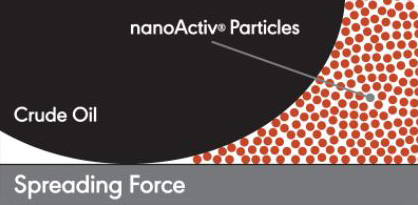
This shows the spreading force of Pig Sweep. The nanoparticles are small enough to permeate the fractures in all types of solids that may be built up on any surface.
Diffusion-driven disjoining pressure
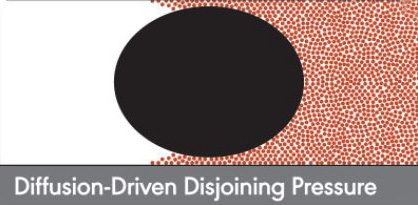
This shows the disjoining or dislodging effect that Pig Sweep has on the solids and debris. Freeing debris from the surface allowing it to be mechanically removed from the pipe and production equipment.
fragmentation
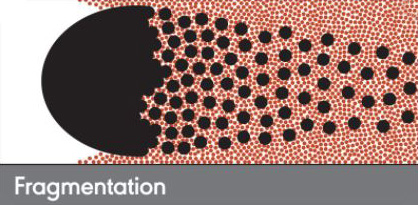
3. RESULTS AND DISCUSSION
The Pig Sweep® product has been field tested in a variety of different pipeline systems, including dry gas transmission pipelines, natural gas gathering pipelines, and natural gas liquid (“NGL”) pipelines. In many cases, the product has been tested in applications where prior cleaning efforts did not achieve the desired results. Below are descriptions of the systems, process, and results from two of these case studies.
3.1 Case Study 1
Case Study 1 involved a typical maintenance cleaning run on multiple segments of a 36-inch nominal diameter, 344-mile dry gas pipeline system. This system flows approximately 1 bscfd and supplies natural gas to four power plants as well as city taps. The operator of the pipeline had previously used a traditional chemical mixture containing kelating agents. During this prior run, the dew point specification was exceeded causing a shutdown of a portion of the system. Using Pig Sweep®, the cleaning process was completed without any production loss and the contract dew point specification was maintained throughout the process. The system was split into several different line segments, and more than 41,000 pounds of solids were removed from the segments cleaned with this product. Below is a detailed description of the process used to clean this system.
One particular segment of the system was an 84-mile pipeline flowing an average of 800 mmscfd at roughly 750 psi resulting in gas velocities of approximately 18 miles per hour. Due to contractual obligations, the flow rate could not be reduced in order to run a cleaning pig at the normal speed of three to seven miles per hour. This meant that a speed control pig was the only option for this line. The Pig Sweep® cleaning product PS-12G was used in conjunction with a speed control pig in a “flush and brush” process. In this process, product is injected in front of the pig and immediately removed instead of spreading product with a spreader pig and removing the product and debris with another more aggressive pig the next day. The speed control pig was set to run between five to seven miles per hour throughout the run.
For the product injection, the 84-mile line segment was broken down into six equal lengths of approximately 14 miles each. The injection quantity was based on a 5-mil (0.005”) coat of product using the pipe ID and the length in miles between each injection point. It was determined that the injection would take place 30 to 45 minutes prior to the pig being launched. The injections at the remaining locations were also done 30 to 45 minutes prior to the pig’s arrival at that injection point. This allows the PS-12G product time to be sprayed along the pipe wall using the gas flow.
Separation equipment was placed at the pig receiver site to separate the liquid and debris which were then captured in Frac tanks. The contents were measured after each run to determine the success of the cleaning run. The process above was repeated three additional times until it was determined that the line was clean. Reduced amounts of PS-12G were used on additional runs.
Using Pig Sweep, the cleaning process was completed without any production loss and the contract dew point specification was maintained throughout the process. The system was split into several different line segments, and more than 41,000 pounds of solids were removed from a 181 mile segment.
3.2 Case Study 2
Case Study 2 was a maintenance cleaning run on a 24-inch nominal diameter, 63-mile dry gas pipeline flowing 260 mmscfd at approximately 850 psi. Prior cleaning runs had been performed using brush pigs and occasionally diesel fuel, without the use of cleaning chemicals. Following these runs, there was no appreciable improvement in operating conditions. Prior to the Pig Sweep® cleaning run, this pipeline required two additional Caterpillar 3616 compressors during normal operation to achieve a flow rate of 260 mmscfd. The gas control on this system allowed for the reduction of flow and therefore velocity during the process. This allowed traditional pigs to be moved at the desired speed for cleaning of three to seven miles per hour. This also allowed for the PS-12G to be spread using a spreader pig followed by a more aggressive pig. In this scenario, the pigs were run at approximately five miles per hour.
This 63-mile pipeline was segregated into three approximately equivalent segments with a launcher and receiver on each segment. The process described below was done on each segment. The first pig used was a foam disc pig in order to remove all free liquid and loose debris from the line segment. Separation equipment was again placed at the receiver to catch all liquid and debris. For the second run, the PS-12G product was injected at the launcher and a second point halfway along the segment, splitting the segment into two roughly equal subsegments. The product was injected 30 to 45 minutes prior to the pig being launched. For this run, a bullet-nosed foam pig with spiral grooves was used to spread the product, allowing it to be spread along the full inner circumference of the line segment maximizing the contact with solids allowing the nanoparticle process to take place.
The third pig was a solid polyurethane cup disc pig equipped with brushes and magnets and was launched 12 hours after receiving the spreader pig. Liquids and debris were captured using separation equipment. This brush pig process was repeated several times until the line segment was deemed clean. This was determined by measuring the liquid and debris received after each run until no further liquids or debris were recovered. After the system was restored back to normal operating conditions, the pipeline showed a significant increase in capacity as shown in Table 1 below.

TABLE 1: OPERATING CONDITIONS BEFORE AND AFTER CLEANING PROCEDURE
The operator was able to shut down two compressors while increasing flow rate due to the increased pipeline efficiency post-cleaning. The compressors have been shut down for 18 months following the cleaning, leading to a reduction in fuel and operating costs of approximately $13,000,000.
The more than 20% increase in throughput resulted in an increase in revenue of approximately $40 million, leading to a combined impact of more than $50 million.
3.3 Laboratory testing
The typical properties required for a typical pipeline chemical or cleaner solution are: wetting, solubilization, emulsification, dispersion, and detergency. These properties are directly applicable to surfactant (surface active) and solvent type chemicals but some of them are generically applicable to other products regardless of the cleaning mechanism. Testing of pipeline cleaning agents is customized based on situational conditions and there are currently no test methods to define industry accepted standards. In most cases, customized testing procedures are developed by in-house production chemistry labs, by large chemical providers, or in collaboration with external specialty labs.
There are some standardized ASTM tests [7,8] primarily designed for application to pharmaceutical, medical, and oxygen manufacturing facilities. These ASTM tests are specifically designed to evaluate the effectiveness of cleaning agents. They provide guidance on how to visually evaluate coupons, calculate a Cleaning Effectiveness Factor (CEF), and a Residual Contamination (Rc) value. This yields both qualitative and quantitative data. Although these tests and others are not specifically designed for pipeline applications, some of the definitions, basic principles, and procedural sections were incorporated into a testing program for the evaluation of Pig Sweep® as a pipeline cleaner [7,8]. Other ASTM tests were evaluated for potential inclusion into the ongoing and future testing programs [9,10,11].
Three basic types of tests were considered for further product evaluation. The first is a basic coupon immersion test (Figures 2 and 3). In this test, contaminated coupons are immersed in the cleaning agent and evaluated afterwards for removal efficiency.

FIGURE 2: LABORATORY BENCHTOP SET-UP FOR COUPON IMMERSION TEST.

FIGURE 3 : ILLUSTRATION OF STANDARD COUPON SIZE FOR CONFORMANCE WITH ASTM 121-98
A second type of test is a Vertical Absorption Test (VAT) (Figure 4), which is used to evaluate a cleaning agent's ability to penetrate a containment

FIGURE 4: ILLUSTRATION OF LABORATORY BENCHTOP SET-UP FOR VERTICAL ABSORPTION TEST.
A third type of test is used to evaluate suspension effects that relate directly to a cleaning product's effectiveness at mass transporting debris along a pipeline or out of a system (Figure 5 and 6). After vigorous mixing to simulate turbulence, the settling time of particles is measured. The lower the settling rate, then the better the suspension.

FIGURE 5: ILLUSTRATION OF PARTICLE SUSPENSION AND SETTLING.

FIGURE 6: PHOTOGRAPH OF BATCH SETTLING COLUMN AT DIFFERENT TIMES.
Final testing procedures have been developed and laboratory tests are currently underway. These tests will be used to optimize Pig Sweep® solvent formulation and concentration for the nanotechnology delivery packages. Additional value will be gained by evaluating cleaning process variables such as contact time, temperature, agitation, and developing optimal cleaning processes.
The testing program included the collection of pigging debris for utilization in the laboratory. Inorganic and organic debris composition was determined using special analytical" techniques. These included Energy Dispersive X-Ray (“EDX”) analysis, X-ray Diffraction Analysis (“XRD”), and organic ignition tests. Additionally, for complete characterization of the testing parameters, full compositional analyses of the pipeline production fluids were obtained, including natural gas, crude oil, condensate, and water.
Tests like these have historically been used to evaluate conventional cleaning products such as chemical surfactants. They may not account for key variables related to nanotechnology product mechanisms (e.g., pressure, Brownian motion, etc.). The ongoing test program will include benchmarking against conventional products and other advanced surface tests.
4. CONCLUSION
Conventional chemicals have had limits to their effectiveness in certain pipeline applications. The use of nanoparticles in pipeline cleaning could change the future of pipeline cleaning. The technology has produced promising results in field testing and case studies to date. There is limited laboratory data and few methods available for evaluating nanotechnology, particularly in this application.
Nano particles are being employed as a promising solution for cleaning oil and gas pipelines as well as surface equipment. These tiny particles offer unique properties that make them effective in removing contaminants and improving pipeline efficiency.
Furthermore , the small size of nano particles enables them to penetrate into tight spaces and narrow passages within the pipelines, ensuring thorough cleaning even in hard-to-reach areas and surface equipment. Their ability to dislodge and suspend deposits, such as scale, rust, and organic matter, helps prevent pipeline blockages and corrosion, thus maintaining optimal flow rates and preventing operational issues.
Their unique properties make them a promising avenue for improving the efficiency and maintenance of oil and gas pipeline and surface equipment, ultimately benefiting the industry and minimizing environmental impacts.
ACKNOWLEDGEMENTS
E&P Services Group
IERP LLC
Assured Flow Solutions
REFERENCES
- [1] By comparison, a sheet of paper is about 100,000 nanometers thick, and a strand of DNA is 2.5 nanometers wide.
- [2] www.nanoactiv.com/resources/faqs.
- [3] Wasan and Nikolov, Nature, Volume 423, 2003.
- [4] www.nanoactiv.com.
- [5] www.nanoactiv.com.
- [6] www.nanoactiv.com/resources/faqs.
- [7] ASTM G122−20 Standard Test Method for Evaluating the Effectiveness of Cleaning Agents and Processes, ASTM
- [8] G121-98 Practice for Preparation of Contaminated Test Coupons for the Evaluation of Cleaning Agents, ASTM E3106 Guide for Science-Based and Risk-Based Cleaning Process Development and Validation.
- [9] ASTM E2834-12 (2018) Standard Guide for Measurement of Particle Size Distribution of Nanomaterials in Suspension by Nanoparticle Tracking Analysis (NTA)
- [10] ASTM E2490 09 (2021) Standard Guide for Measurement of Particle Size Distribution of Nanomaterials in Suspension by Photon Correlation Spectroscopy (PCS)
- [11] ASTM E3247 20 Standard Test Method for Measuring the Size of Nanoparticles in Aqueous Media Using Dynamic Light Scattering.

